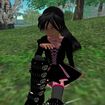User:Lum Pfohl/SL Trivia
Jump to navigation
Jump to search
SL TriviaThese are things I've noticed about SL over the course of a year. In no particular order at this time:
Lum Pfohl 06:55, 29 November 2007 (PST) |
|
